
Expansion of the Qin dynasty
This is a timeline of the Warring States period (481 BC – 403 BC) and the Qin state (9th century BC – 221 BC) and dynasty (221 BC – 206 BC).
9th century BC
| Year | Date | Event |
|---|---|---|
| 897 BC | Horse breeder Feizi is given the fief of Qin in modern Zhangjiachuan Hui Autonomous County[1] | |
| 858 BC | Feizi dies and is succeeded by the Marquis of Qin | |
| 848 BC | The Marquis of Qin dies and is succeeded by Gongbo | |
| 845 BC | Gongbo dies and is succeeded by Qin Zhong | |
| 822 BC | Qin Zhong is killed in battle by the Xirong[1] and is succeeded by Duke Zhuang of Qin |
8th century BC
| Year | Date | Event |
|---|---|---|
| 778 BC | Duke Zhuang of Qin dies and is succeeded by Duke Xiang of Qin | |
| 770 BC | Duke Xiang of Qin sends an army to protect King Ping of Zhou[2] | |
| 766 BC | Duke Xiang of Qin dies and is succeeded by Duke Wen of Qin | |
| 753 BC | Annalists are established in Qin[3] | |
| 750 BC | Qin defeats the Xirong in battle and annexes the land they occupied[2] | |
| 716 BC | Duke Wen of Qin dies and is succeeded by Duke Xian of Qin | |
| 704 BC | Duke Xian of Qin dies and is succeeded by Chuzi I |
7th century BC
| Year | Date | Event |
|---|---|---|
| 698 BC | Chuzi I is assassinated and succeeded by Duke Wu of Qin | |
| 688 BC | The county (縣 xiàn) is mentioned for the first time in Qin[4] | |
| 678 BC | Duke Wu of Qin dies and is succeeded by Duke De of Qin | |
| Qin starts practicing human sacrifice at burials[3] | ||
| 677 BC | Qin moves its capital to Yong in modern Fengxiang[1] | |
| 676 BC | Duke De of Qin dies and is succeeded by Duke Xuan of Qin | |
| 664 BC | Duke Xuan of Qin dies and is succeeded by Duke Cheng of Qin | |
| 660 BC | Duke Cheng of Qin dies and is succeeded by Duke Mu of Qin | |
| 650 BC | Earliest archaeological evidence of crossbows[5] | |
| 645 BC | Qin annexes Jin territory west of the Yellow River[2] | |
| 623 BC | Qin deals a major defeat to the Xirong and expands further west[1] | |
| 621 BC | Duke Mu of Qin dies and is succeeded by Duke Kang of Qin | |
| 609 BC | Duke Kang of Qin dies and is succeeded by Duke Gong of Qin | |
| 604 BC | Duke Gong of Qin dies and is succeeded by Duke Huan of Qin |
6th century BC
| Year | Date | Event |
|---|---|---|
| 577 BC | Duke Huan of Qin dies and is succeeded by Duke Jing of Qin | |
| 544 BC | Sunzi is born | |
| 537 BC | Duke Jing of Qin dies and is succeeded by Duke Ai of Qin | |
| 513 BC | Penal laws are inscribed on iron tripod vessels in Qin[6] | |
| 501 BC | Duke Ai of Qin dies and is succeeded by Duke Hui I of Qin |
5th century BC
| Year | Date | Event |
|---|---|---|
| 500 BC | Cast iron tools[7] | |
| 496 BC | Sun Tzu dies | |
| 492 BC | Duke Hui I of Qin dies and is succeeded by Duke Dao of Qin | |
| 479 BC | Kongfuzi dies[8] | |
| 477 BC | Duke Dao of Qin dies and is succeeded by Duke Ligong of Qin | |
| 473 BC | Battle of Li River: Goujian of Yue attacks Fuchai of Wu while their forces are out on an expedition against Lu and Qi, resulting in the annexation of Wu[9] | |
| 470 BC | Mozi is born | |
| 462 BC | Qin seizes Wangcheng[10] | |
| 447 BC | Chu (state) conquers Cai | |
| 443 BC | Duke Ligong of Qin dies and is succeeded by Duke Zao of Qin | |
| 440 BC | Wu Qi is born | |
| 430 BC | The Xirong attack Qin[1] | |
| 429 BC | Duke Zao of Qin dies and is succeeded by Duke Huai of Qin | |
| 425 BC | Duke Huai of Qin kills himself and is succeeded by Duke Ling of Qin | |
| 418 BC | Qi annexes Xue | |
| 415 BC | Duke Ling of Qin dies and is succeeded by Duke Jian of Qin | |
| 412 BC | Qin goes to war with Wei[11] | |
| 408 BC | First recorded grain tax in Qin[2] |
4th century BC
| Year | Date | Event |
|---|---|---|
| 400 BC | Duke Jian of Qin dies and is succeeded by Duke Hui II of Qin | |
| The commandery (郡 jùn) is mentioned for the first time in Wei[12] | ||
| Iron plough[6] | ||
| 391 BC | Mozi dies | |
| 390 BC | Shang Yang is born | |
| 387 BC | Duke Hui II of Qin dies and is succeeded by Chuzi II | |
| 385 BC | Chuzi II is killed and succeeded by Duke Xian of Qin (424–362 BC) | |
| Wei conquers Qin territory west of the Yellow River[2] | ||
| 384 BC | Qin officially bans the practice of human sacrifice at burials[3] | |
| 381 BC | Wu Qi dies | |
| 375 BC | Han conquers Zheng | |
| 372 BC | Mencius is born | |
| 369 BC | Chu conquers Zou | |
| Zhuang Zhou is born | ||
| 362 BC | Duke Xian of Qin (424–362 BC) dies and is succeeded by Duke Xiao of Qin[11] | |
| 350 BC | Qin moves its capital to Xianyang[1] | |
| Qin creates 31 counties to be administered by centrally appointed magistrates[13] | ||
| Qin abolishes the fixed land tenure system[13] | ||
| 344 BC | Qin standardizes weights and measures[14] | |
| 340 BC | Qin retakes territory lost to Wei[11] | |
| 338 BC | Duke Xiao of Qin dies and is succeeded by King Huiwen of Qin | |
| Shang Yang is killed[11] | ||
| 336 BC | Qin issues its first currency[8] | |
| 334 BC | Chu conquers Yue | |
| 326 BC | Qin starts celebrating the New Year[3] | |
| 317 BC | Qin defeats the coalition army of Han, Zhao, and Wei[15] | |
| 316 BC | Qin annexes Shu and Ba[16] | |
| 315 BC | Qin captures 25 settlements from the Xirong[1] | |
| 313 BC | Xun Kuang is born | |
| 312 BC | Qin defeats a Chu army[15] | |
| 311 BC | King Huiwen of Qin dies and is succeeded by King Wu of Qin | |
| 309 BC | Qin creates the offices of chancellors of the right and left[14] | |
| 307 BC | King Wu of Qin dies and is succeeded by King Zhaoxiang of Qin |
3rd century BC
| Year | Date | Event |
|---|---|---|
| 297 BC | Song conquers Teng | |
| 296 BC | Zhao conquers Zhongshan | |
| 289 BC | Mencius dies | |
| 286 BC | Qi conquers Song | |
| Zhuang Zhou dies | ||
| 280 BC | Han Fei is born | |
| 278 BC | Qin sacks Ying, the capital of Chu[15] | |
| 272 BC | Qin annexes Yiqu | |
| 266 BC | According to a noble in Wei, "Qin has the same customs as the Rong and Di [barbarians]. It has the heart of a tiger or a wolf... It knows nothing about traditional mores, proper relationships, and virtuous conduct."[1] | |
| 262 BC | Battle of Changping: Qin deals a major defeat to Zhao[17] | |
| 256 BC | Qin annexes Eastern Zhou[14] | |
| Li Bing constructs the Dujiangyan[18] | ||
| 250 BC | King Zhaoxiang of Qin dies and is succeeded by King Xiaowen of Qin and then King Zhuangxiang of Qin | |
| 249 BC | Chu conquers Lu | |
| 247 BC | 7 May | King Zhuangxiang of Qin dies and is succeeded by King Zheng of Qin |
| 246 BC | The Zhengguo Canal is constructed[19] | |
| 238 BC | Xun Kuang dies | |
| 233 BC | Han Fei is killed[19] | |
| 230 BC | Qin annexes Han[20] | |
| 228 BC | Qin annexes Zhao[20] | |
| 227 BC | Jing Ke fails to assassinate King Zheng of Qin[20] | |
| 225 BC | Qin annexes Wei[20] | |
| 223 BC | Qin annexes Chu[20] | |
| 222 BC | Qin annexes Yan[20] | |
| 221 BC | Qin annexes Qi[20] | |
| King Zheng of Qin becomes the First Emperor of Qin[21] | ||
| Meng Tian starts construction of the Great Wall of China[22] | ||
| 220 BC | Construction of imperial highways begins[23] | |
| 219 BC | The emperor gets mad at a mountain god, so he orders the mountain to be denuded and painted red[24] | |
| The Lingqu "magic transport" canal is constructed, linking the Changjiang to Dongting Lake[25] | ||
| 214 BC | Qin's campaign against the Xiongnu: Meng Tian defeats the Xiongnu and conquers the Ordos region[26] | |
| Qin's campaign against the Yue tribes: Qin expands into modern Guangdong, Guangxi, and Fujian, adding four new commanderies to the empire[26] | ||
| Colonists are sent to Guilin, Xiang, and Nanhai[27] | ||
| 213 BC | Burning of books and burying of scholars | |
| Colonists are sent to modern Guangdong and northern Vietnam[27] | ||
| 212 BC | Construction of the Epang Palace begins[26] | |
| Construction of the Qin Mausoleum begins[26] | ||
| 211 BC | An inauspicious comet is sighted, causing the emperor to kill everyone around the area where it fell[28] | |
| Colonists are sent to Ordos[27] | ||
| 210 BC | Xu Fu returns from his voyage to find the elixir of life and blames his failure on sea monsters so the emperor goes fishing[28] | |
| 10 September | The First Emperor of Qin dies[29] | |
| October | Zhao Gao and Li Si enthrone the Second Emperor of Qin; the brother Fusu kills himself and Meng Tian is imprisoned[29] | |
| 209 BC | Qin annexes Wey | |
| Dazexiang uprising: Chen Sheng and Wu Guang rebel[30] | ||
| 208 BC | January | Dazexiang uprising: Chen Sheng and Wu Guang are assassinated but the rebellion continues under other leaders such as Liu Bang and Xiang Yu[31] |
| August | Li Si is killed[31] | |
| 207 BC | August | Battle of Julu: Qin general Zhang Han surrenders to Xiang Yu[31] |
| October | The Second Emperor of Qin kills himself and Zhao Gao replaces him with Ziying, who stabs Zhao to death[31] | |
| November | Ziying surrenders to Liu Bang; so ends the Qin dynasty[31] |
Gallery
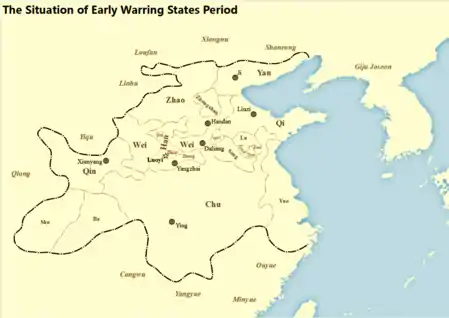 Early Warring States period
Early Warring States period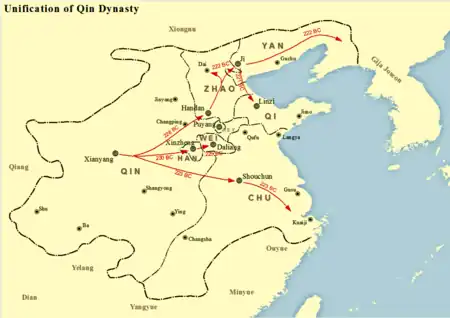 Qin campaigns against the Warring States
Qin campaigns against the Warring States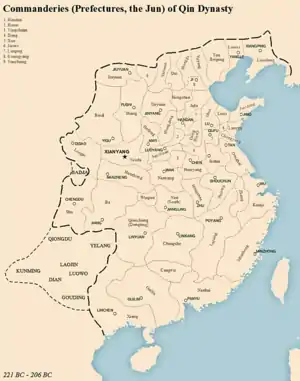 Qin dynasty
Qin dynasty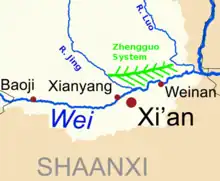
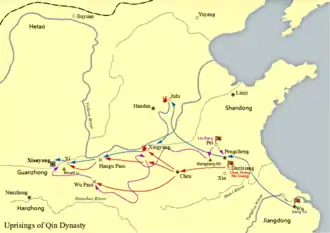 Uprisings
Uprisings
See also
Citations
- 1 2 3 4 5 6 7 8 Twitchett 2008, p. 31.
- 1 2 3 4 5 Twitchett 2008, p. 33.
- 1 2 3 4 Twitchett 2008, p. 32.
- ↑ Twitchett 2008, p. 25.
- ↑ Loades 2018.
- 1 2 Twitchett 2008, p. 23.
- ↑ Ebrey 2005, p. 30.
- 1 2 Twitchett 2008, p. 29.
- ↑ Whiting 2002, p. 62.
- ↑ Whiting 2002, p. 63.
- 1 2 3 4 Twitchett 2008, p. 34.
- ↑ Twitchett 2008, p. 26.
- 1 2 Twitchett 2008, p. 35.
- 1 2 3 Twitchett 2008, p. 38.
- 1 2 3 Peers 2013, p. 59.
- ↑ Twitchett 2008, p. 40.
- ↑ Twitchett 2008, p. 99.
- ↑ Twitchett 2008, p. 45.
- 1 2 Twitchett 2008, p. 44.
- 1 2 3 4 5 6 7 Twitchett 2008, p. 46.
- ↑ Twitchett 2008, p. 53.
- ↑ Twitchett 2008, p. 62.
- ↑ Twitchett 2008, p. 61.
- ↑ Twitchett 2008, p. 80.
- ↑ Twitchett 2008, p. 65.
- 1 2 3 4 Twitchett 2008, p. 64.
- 1 2 3 Twitchett 2008, p. 66.
- 1 2 Twitchett 2008, p. 79.
- 1 2 Twitchett 2008, p. 82.
- ↑ Twitchett 2008, p. 83.
- 1 2 3 4 5 Twitchett 2008, p. 84.
Bibliography
- Ebrey, Patricia (2005), China: A Cultural, Social, and Political History, Wadsworth Publishing
- Li, Xiaobing, ed. China at War: An Encyclopedia. Santa Barbara: ABC-CLIO, 2012. online
- Loades, Mike (2018), The Crossbow, Osprey
- Peers, C.J. (2006), Soldiers of the Dragon: Chinese Armies 1500 BC - AD 1840, Osprey Publishing Ltd
- Peers, Chris (2013), Battles of Ancient China, Pen & Sword Military
- Twitchett, Denis (2008), The Cambridge History of China 1, Cambridge University Press
- Whiting, Marvin C. (2002), Imperial Chinese Military History, Writers Club Press
This article is issued from Wikipedia. The text is licensed under Creative Commons - Attribution - Sharealike. Additional terms may apply for the media files.